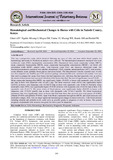| dc.contributor.author | Gitari, AN | |
| dc.contributor.author | Nguhiu-Mwangi, J | |
| dc.contributor.author | Mogoa, EM | |
| dc.contributor.author | Varma, VJ | |
| dc.contributor.author | Mwangi, WE | |
| dc.contributor.author | Konde, AM | |
| dc.contributor.author | Rashid, FK | |
| dc.date.accessioned | 2018-02-15T08:53:07Z | |
| dc.date.available | 2018-02-15T08:53:07Z | |
| dc.date.issued | 2017 | |
| dc.identifier.citation | Gitari AN, J Nguhiu-Mwangi, EM Mogoa, VJ Varma, WE Mwangi, AM Konde and FK Rashid, 2016. Haematological and biochemical changes in horses with colic in Nairobi County, Kenya. Inter J Vet Sci, 5(4): 250-255. www.ijvets.com | en_US |
| dc.identifier.uri | https://www.cabdirect.org/cabdirect/abstract/20173094118?q=(((%22university+of+nairobi+2017%22+OR+(university+of+nairobi+2017)))) | |
| dc.identifier.uri | http://hdl.handle.net/11295/103437 | |
| dc.description.abstract | This was a prospective study, which involved following up cases of colic and from which blood samples for
haematology and serum for biochemical analysis were collected. The haematological parameters measured were total
erythrocyte count (TEC), haemoglobin concentration (Hb), Haematocrit (hct), mean corpuscular volume (MCV),
mean corpuscular haemoglobin (MCH), mean corpuscular haemoglobin concentartion (MCHC), red blood cell
distribution width (RDW), platelet count, Total leucocyte count (TLC) and leucocyte differential count. The
biochemical parameters measured were alkaline phosphatase (ALP), aspartate aminotransferase (AST), total proteins,
serum albumin, serum globulin, blood glucose and serum lactate. The data obtained from the reported cases of colic
was then imported into StatPlus pro 5.9.8 statistical package and means±SD were calculated and student t-test was
then used to compare the means from horses that had impaction colic with those that had spasmodic colic as well as
the means of those horses that recovered with those of the horses that died. The level of significance was at P<0.05.
Mean corpuscular haemoglobin (MCH) was significantly higher (P=0.03) in horses with spasmodic colic (16.8±1.3
pg) than in those with impaction colic (15.6±1.2 pg). The mean leucocyte count (109
/L) was significantly higher
(p=0.02) in horses with impaction colic (12.9±5.9) than in those with spasmodic colic (9.0±1.5). Similarly, mean
neutrophil count (109
/L) was significantly higher (P=0.02) in horses with impaction colic (9.1±5.6) than in those with
spasmodic colic (5.4±1.7). The mean values of blood glucose were significantly higher (P=0.02) in horses with
impaction colic (5.7±2.0 mmol/l) than in those with spasmodic colic (3.7±1.4 mmol/l). The blood biochemical
parameters that were significantly lower in horses that died than those that survived were total protein (P=0.002),
albumin (P<0.01) and globulin (P=0.04). Apart from Mean corpuscular hemoglobin (MCH), and slight leucocyte and
neutrophil changes, there were no major significant haematological changes in horses with colic. Total blood proteins
including albumin and globulin levels could serve as possible guides to prognosis of colic in horses. The general
prognosis of spasmodic colic in horses was good, but fair to poor for impaction. | en_US |
| dc.language.iso | en | en_US |
| dc.publisher | University of Nairobi | en_US |
| dc.rights | Attribution-NonCommercial-NoDerivs 3.0 United States | * |
| dc.rights.uri | http://creativecommons.org/licenses/by-nc-nd/3.0/us/ | * |
| dc.subject | Horses, Colic, Hematology, Biochemistry, Diagnostic, Prognostic, Indicators | en_US |
| dc.title | Hematological and biochemical changes in horses with colic in Nairobi county, Kenya. | en_US |
| dc.type | Article | en_US |



